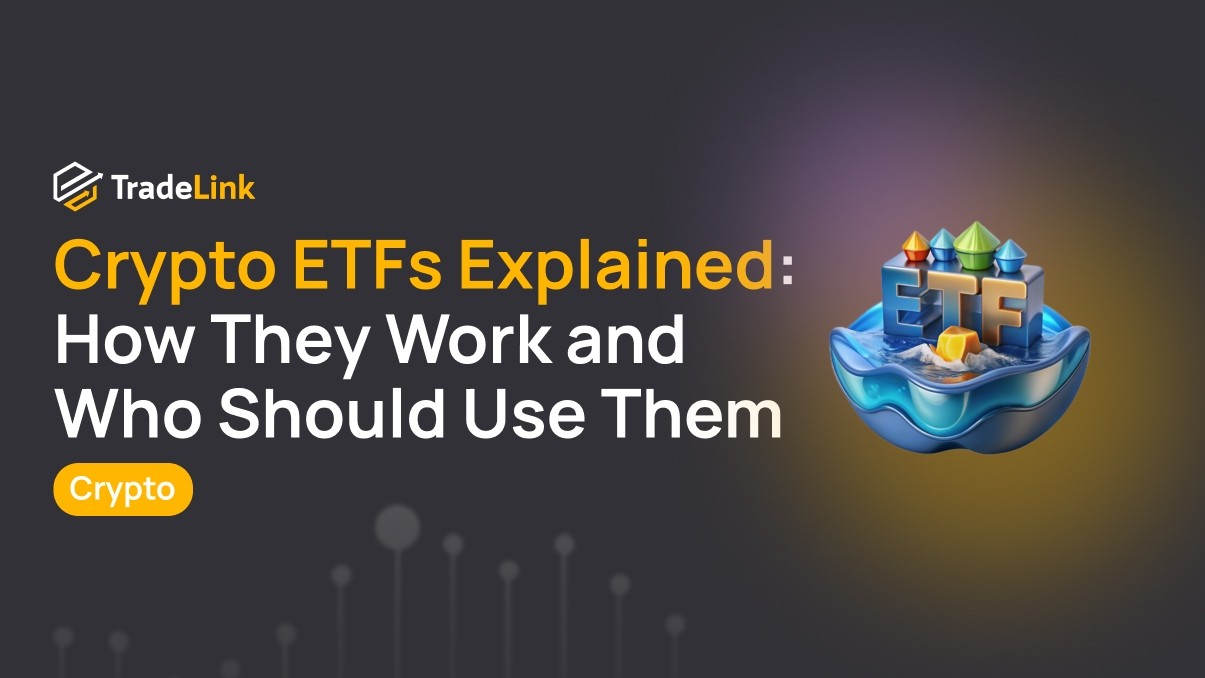Crypto ETFs Explained: How They Work and Who Should Use Them

Contents
- Introduction
- What Is an ETF
- Benefits and Risks
- Choosing a Broker and Registration
- The Future of Cryptocurrency ETFs
- Conclusion
Introduction
An ETF is a tool that has simplified access to investing. It became popular in traditional markets and is now actively entering the world of cryptocurrencies. Crypto ETFs make the digital asset market more understandable and accessible to a broader audience. Previously, investors had to buy cryptocurrency themselves, set up wallets, and think about storage. It’s enough to purchase a share in a fund that handles all that.
The emergence of cryptocurrency ETFs is a significant milestone. It signals the industry’s maturity. Large players and regulators are increasingly paying attention to such products. This lowers the entry barrier for new investors in the crypto market.
What Is an ETF

An ETF (Exchange-Traded Fund) is a convenient way to invest in a basket of assets at once. Instead of buying each cryptocurrency separately, an investor purchases a share of a pre-assembled “basket” managed by an asset management company. This share is traded on an exchange like an ordinary stock: it can be bought or sold at any time, and its price depends on the value of all the assets it contains.
The advantage of this approach lies in its simplicity. There’s no need to deeply understand each asset—just choose and invest in the right fund. The asset manager has already built the portfolio and keeps it current.
A similar principle is used in other modern tools targeting the crypto market. For example, the Tradelink Marketplace offers crypto indexes—curated sets of algorithmic strategies managed by top traders.
This provides an opportunity to invest in the market without understanding every strategy or managing assets manually. You simply choose an index with an appropriate risk level and starting capital.
Features of Crypto ETFs
A cryptocurrency ETF works under the same principle as a traditional exchange-traded fund: it allows you to invest in an asset without directly buying it. In the case of a crypto ETF, the asset is a cryptocurrency, most often Bitcoin or Ethereum, as they are the most liquid and institutionally recognized. ETFs for other cryptocurrencies are still rarely available on regulated markets.
There are two types of such funds:
-
Spot ETFs, which are backed by actual cryptocurrency and reflect its price directly;
-
Futures ETFs track cryptocurrency prices through derivative financial instruments.
One of the main goals of crypto ETFs is to make investing in cryptocurrency safer and more convenient. Users don’t need to create crypto wallets or fear losing access to their tokens. That responsibility lies with custody providers—specialized organizations that store the fund’s cryptocurrency and ensure its security.
It’s also important to understand that crypto ETFs are subject to financial regulations. Regulatory bodies such as the SEC oversee their operations. This increases trust among traditional investors.
Formation and Collateral Mechanism
Creating a cryptocurrency ETF starts with assembling a portfolio of digital assets that will form the fund’s basis. The asset manager purchases these assets on exchanges or via OTC desks. Then, the cryptocurrency is handed over to a custodian—a licensed company specializing in digital asset security.
The fund’s assets are stored separately from the manager’s funds and are insured. Access is regulated through smart contracts or multi-factor procedures, including multisignatures and offline storage.
Once the assets are secured, the fund issues shares (or ETF units), strictly corresponding to the amount of cryptocurrency held. This process is called creation/redemption. When new investments come in, the manager must buy additional crypto assets, and when money is withdrawn, a corresponding amount is sold.
This ensures the fund’s complete and transparent collateral. Each share’s Net Asset Value (NAV) is calculated in real time, keeping ETF prices in sync with the market value of the underlying crypto.
This structure’s reliability is ensured through clear role separation: the custodian handles storage and security, while the asset manager is responsible for trading, issuing shares, and regulatory compliance.
Trading Dynamics and Liquidity
Crypto ETF shares are traded on exchanges like regular stocks. Their price depends on the value of the cryptocurrency held in the fund. However, the share price doesn’t always exactly match the actual asset value due to supply and demand on the exchange.
If demand is high, the share price may rise above NAV. If demand is low, it may fall below. To minimize this gap, market makers are involved. These participants buy and sell ETF shares to stabilize the market.
Liquidity—the ability to quickly buy or sell a share at a fair price—is influenced by:
-
Trading volume — higher volume means it’s easier to sell without losses
-
Bid-ask spread — the smaller it is, the better the trade
-
Trader activity — the more participants on the exchange, the easier it is to make transactions
Market news and sentiment also matter. During intense price swings in crypto markets, liquidity can decrease. ETF shares may temporarily trade above or below their real value at such times.
Benefits and Risks

Investor Benefits
-
Easy access to cryptocurrencies
No need for wallets, private keys, or special platforms. Everything is purchased through a regular broker. -
Low entry barrier
You can invest small amounts without buying a whole Bitcoin or learning DeFi. -
Familiar trading tools
ETF shares are bought and sold just like stocks—convenient for those familiar with the stock market. -
Secure storage
Custodians handle storage. Investors don’t risk losing access due to errors or wallet hacks. -
Institutional access
ETFs allow large companies and funds to enter the crypto market without directly holding tokens.
Main Risks
-
Volatility
The share price reflects crypto prices directly—sharp rises or drops are mirrored in real time. -
Counterparty risk
Funds are managed by third parties. If they fail in their duties, investor assets could be at risk. -
Fees
Asset managers charge maintenance fees, reducing investor net returns. -
Legal restrictions
Crypto ETFs may be unavailable or restricted in certain countries. Legal changes can affect the market.
Choosing a Broker and Registration

To start investing in a crypto ETF, select a suitable broker. The table below lists key criteria to help you decide:
Criterion | What to Check | Why It Matters |
Availability of crypto ETFs | Whether spot or futures ETFs are offered | Not all brokers provide access to these products |
Registration and license | Is the broker licensed and regulated | Protects against fraud and withdrawal issues |
Fees | Purchase, holding, and selling fees | High fees reduce profitability |
Platform usability | Ease of use of the website or app | A user-friendly platform helps you onboard quickly |
Support and reviews | Availability of support and user feedback | Useful in case of errors or difficulties |
After choosing a broker, you must register by entering personal data and uploading documents. Then you can fund your account and proceed to purchase crypto ETFs.
Buying and Managing a Position
Buying a cryptocurrency ETF through a broker involves a few standard steps. It occurs on a familiar trading interface and doesn’t require technical expertise.
-
Funding your account
Your brokerage account must have funds. Brokers typically accept bank cards, wire transfers, or e-wallets. Once the funds are credited, you can move to the next step. -
Finding the ETF
Find the specific fund using the broker’s platform. This is easiest via its ticker symbol—for example, one popular Bitcoin futures ETF is BITO. -
Placing an order
Select the number of shares. Choose order type—market (at current price) or limit (at a set price). Upon confirmation, funds are debited, and ETF shares are credited to your account. -
Monitoring the position
After purchase, track the share price, yield, and other metrics via your broker’s dashboard. Some platforms also offer real-time charts, P&L data, and analytics. -
Selling the asset
To exit the position, sell the ETF the same way—via an order through the broker’s app or website. Funds return to your account and are available for withdrawal or reinvestment.
The Future of Cryptocurrency ETFs

Trends and New Products
The crypto ETF market continues to evolve. After the first Bitcoin ETFs, interest has shifted toward broader solutions. One direction is DeFi ETFs. These include tokens of decentralized protocols like Uniswap or Aave, allowing investment in the sector.
Tokenized funds are also emerging structures where ETF shares are issued as tokens on a blockchain. This simplifies accounting, increases transparency, and lowers costs. Some platforms are testing hybrid models, combining traditional and crypto assets.
Another trend is the development of multi-asset ETFs. These funds may include Bitcoin, Ethereum, stablecoins, and other digital assets, diversifying risk.
Regulatory Outlook
The regulatory approach to crypto ETFs remains inconsistent. In the U.S., the SEC oversees such products. It has approved several future ETFs but has long resisted spot ETF approvals. However, recent decisions signal a shift in stance.
In Europe, the situation is simpler. Some countries allow crypto asset funds but require strict oversight. The European Union (EU) is implementing custody, reporting, and investor protection rules. These don’t ban crypto ETFs but make issuance more demanding.
Local central banks vary in attitude—some are open to innovation, others remain restrictive. These differences hinder the launch of global products.
Conclusion
Cryptocurrency ETFs have become an essential part of the digital economy. They opened the market to new investors and simplified access to what was once a complex space. Thanks to these funds, investing in Bitcoin and other assets is easier without directly buying or storing them.
The development of ETFs signals the maturing of the crypto industry. Institutional interest is growing, product offerings are expanding, and regulators are gradually defining clear rules.
For beginner investors, crypto ETFs are one of the safest ways to enter the market. But it’s essential to understand the risks, stay informed, and choose reliable brokers. This tool can then become part of a stable and thoughtful investment strategy.